Psoriasis Under Fingernails: Challenges and Insights
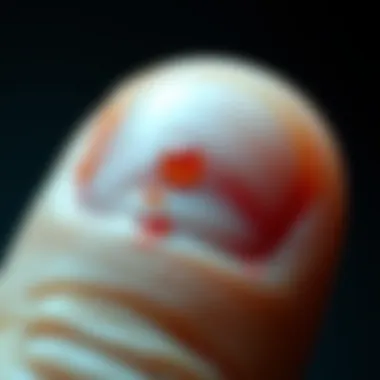
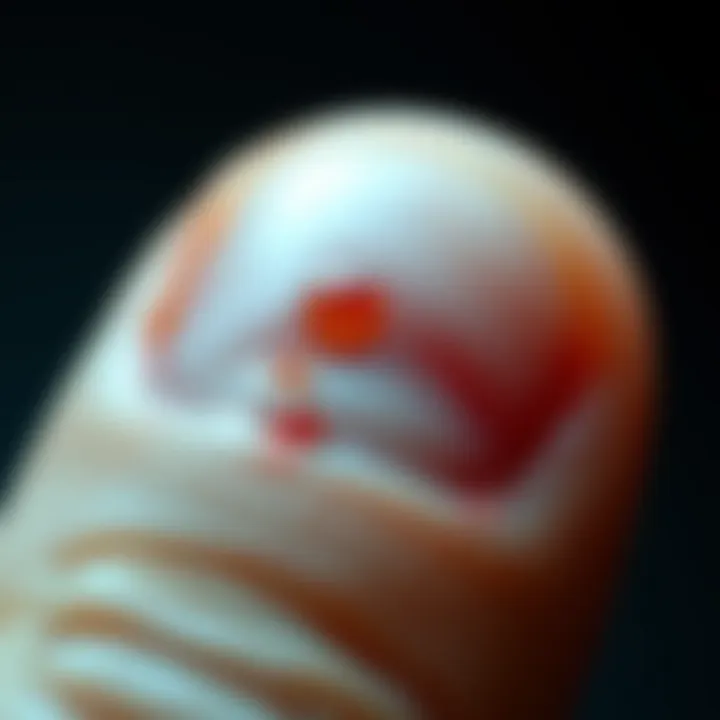
Intro
Psoriasis, a chronic autoimmune skin disorder, often finds itself at the forefront of discussions about skin health. However, what lurks beneath the surface, particularly under the fingernails, is a dimension of this condition that tends to be overshadowed. Fingernail psoriasis is not just an aesthetic concern; it can impact an individual's daily life significantly. Understanding the intricacies of this condition is crucial for both patients and healthcare professionals alike.
Key Concepts and Terminology
Understanding psoriasis beneath the fingernails necessitates familiarity with specific terminology and concepts that frame this complex relationship between the immune system and dermatological manifestations.
Definition of Key Terms
- Psoriasis: A chronic skin condition characterized by rapid skin cell production, leading to red, inflamed patches, often covered with silvery-white scales.
- Nail Psoriasis: A type of psoriasis that affects the nails, leading to symptoms such as pitting, discoloration, and even nail separation from the nail bed.
- Pathophysiology: The functional changes that occur within the body due to a disease or medical condition, in this case, how psoriasis affects nail health.
Concepts Explored in the Article
- The relationship between systemic psoriasis and nail manifestations.
- Assessment and diagnostic criteria for identifying nail psoriasis.
- Treatment modalities available, and their implications for symptom management.
- The broader impact of nail psoriasis on a person's quality of life.
Findings and Discussion
Main Findings
The clinical presentation of nail psoriasis can vary widely among individuals, making it sometimes elusive and difficult to diagnose. Common symptoms include:
- Nail Pitting: Tiny dents or depressions on the surface of the nails.
- Subungual Hyperkeratosis: Thickening of the skin under the nail, leading to nail lifting and potential pain.
- Discoloration: Nails can take on yellow, brown, or even greenish hues, depending on the severity and associated infections.
Moreover, the pathophysiology linking systemic psoriasis with nail health reveals a compelling narrative about the immune system's role in inflammation and cell turnover in the nail matrix. The understanding of these mechanisms is vital for developing targeted treatment strategies.
Potential Areas for Future Research
Research into nail psoriasis remains sporadic, highlighting several potential avenues for deeper exploration:
- The effectiveness of novel biologics and systemic treatments tailor-made for nail involvement.
- Longitudinal studies examining the impact of nail psoriasis on psychological well-being.
- Investigations into the relationship between corticosteroid use and nail health outcomes.
"The way psoriasis affects nails is a reflection of the broader disease, echoing the need for a comprehensive treatment approach."
In summary, psoriasis under the fingernails is an often underestimated aspect of this pervasive condition. A nuanced comprehension of its symptoms, diagnostic challenges, and treatment options not only informs clinical practice but also helps in addressing the psychological and social implications of living with this condition.
Prelude to Nail Psoriasis
Nail psoriasis is a condition that often flies under the radar, overshadowed by its more visible counterparts. However, it's essential to recognize the significance of this ailment, as it carries distinct implications for those affected. Understanding nail psoriasis can unlock insight into a person's overall health and emotional well-being. The influence of psoriasis beneath the fingernails is both literal and metaphorical, marking an intersection where physical symptoms meet psychological challenges.
The symptoms can range from discoloration and ridges to painful nail bed issues. They are not merely cosmetic concerns; they can reflect systemic health issues and profoundly impact one's self-esteem and daily life. Grasping the nuances of nail psoriasis facilitates better management strategies, contributes to improved care protocols, and enhances the quality of life for those suffering from this condition.
Why This Matters
As dermatological issues go, nail psoriasis is often dismissed or attributed to other factors. However, this oversight poses a risk to proper diagnosis and effective treatment. Here’s why paying attention to nail psoriasis matters:
- Specific Symptoms: Unlike skin psoriasis, which may show plaques and itchiness, nail psoriasis can manifest in more subtle ways, often mistaken for fungal infections or trauma.
- Potential Associations: Nail psoriasis may connect to other psoriatic conditions, indicating a more extensive autoimmune response.
- Management Effects: Both psychological and physical impacts of cosmetic nail damage can ripple through a person's life, affecting social interactions and professional opportunities.
By shedding light on this topic, we aim to inform and equip readers with the knowledge needed to understand, recognize, and manage nail psoriasis—a condition that warrants the same level of attention as other psoriatic manifestations.
Pathophysiology of Nail Psoriasis
Understanding the pathophysiology of nail psoriasis is crucial in effectively diagnosing and treating this condition. This intricate process sheds light on the underlying mechanisms that contribute to the manifestation of symptoms, aiding healthcare professionals in formulating tailored therapeutic strategies. Moreover, a grasp of the pathophysiology informs patients about the condition’s nature, empowering them to manage it more effectively.
Immune System Involvement
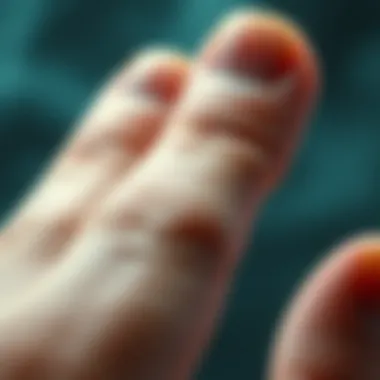
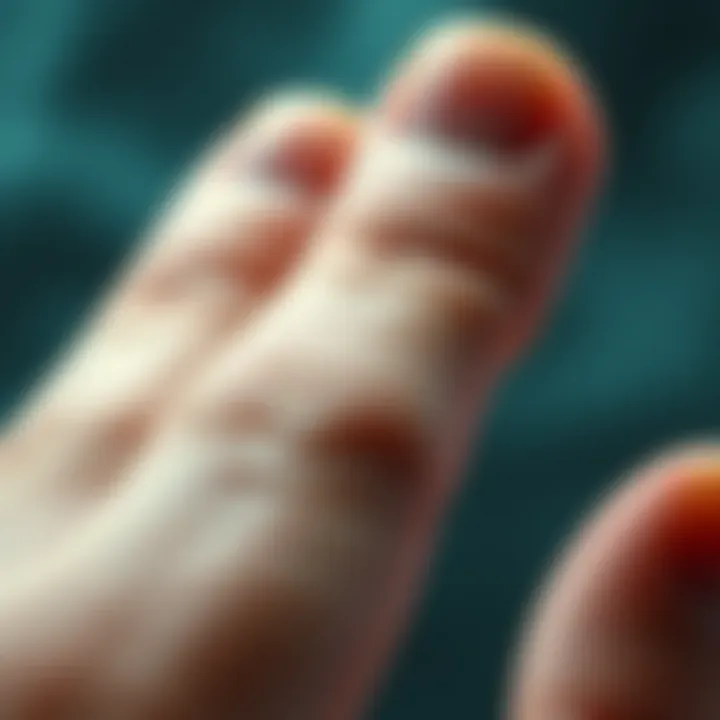
At the heart of nail psoriasis lies the immune system. Research suggests that this condition is predominantly fueled by an aberrant immune response. T-cells, a type of white blood cell, often go haywire in individuals suffering from psoriasis, mistakenly attacking healthy skin cells and nails. This attack triggers an inflammatory cascade, leading to hyperproliferation of keratinocytes—the cells that make up the outer layer of the skin.
The inflammation creates an environment that supports the growth of abnormal nail cells, leading to the distinctive changes seen in nail psoriasis. For example, nail pitting, a common symptom, occurs due to the acceleration of cell turnover, where the skin cells multiply faster than usual, resulting in uneven surfaces on the nails. Moreover, it’s worth mentioning that conditions like psoriatic arthritis can complicate matters, linking joint issues with nail changes.
Nail psoriasis doesn’t just affect aesthetics; it can be a window into systemic autoimmune disorders.
Genetic Factors
Genetics play a starring role in the development of nail psoriasis. Twin studies and familial assessments have shown that this condition has a hereditary component. Variations in certain genes, particularly those linked to the immune system, can predispose individuals to developing this disease. Specific genetic markers, such as HLA-Cw6, have been frequently associated with psoriasis.
Understanding the genetic underpinnings allows researchers to identify individuals at higher risk and potentially develop targeted therapies. Furthermore, knowledge of genetic predispositions feeds into a larger discussion on personalized medicine, suggesting treatments that could adapt to an individual’s unique genetic makeup.
Environmental Triggers
While genetics lay the groundwork, it's often the environmental factors that spark the fire of nail psoriasis. Various triggers can provoke or exacerbate the condition. Stress is arguably one of the most significant contributors—stressful life events can lead to flare-ups, affecting both skin and nail health.
Infections, particularly streptococcal infections, can also act as a catalyst for those already predisposed. Other environmental influences include:
- Injury to the nail (also known as the Koebner phenomenon)
- Certain medications, notably lithium or beta-blockers
- Weather conditions, with cold and dry environments often worsening symptoms
- Lifestyle factors, including smoking and heavy alcohol consumption
By recognizing these triggers, individuals can adopt preventive strategies to mitigate their effects, fostering better management of nail psoriasis.
Clinical Manifestations
Understanding the clinical manifestations of nail psoriasis is pivotal for medical professionals and laypersons alike. This understanding not only helps in identifying the condition early but also in tailoring the treatment effectively. The signs and symptoms that arise beneath the fingernails can significantly affect both a person's physical appearance and their overall quality of life. Hence, an informed approach towards recognizing these manifestations is integral for optimal management and education on the topic.
Common Symptoms
Nail psoriasis presents with a variety of symptoms that can differ in severity and visibility. Recognizing these symptoms is paramount to discerning nail psoriasis from other conditions. Here are some of the common signs one might encounter:
- Nail Pitting: Small depressions or dimples appear on the nail surface. This symptom often happens alongside other dermatological manifestations and can vary greatly in size.
- Onycholysis: This term describes the detachment of the nail plate from the underlying nail bed. It can create a space that may become vulnerable to infections.
- Discoloration: Nails may appear yellow or brownish due to the condition. This discoloration can sometimes be mistaken for fungal infections, leading to diagnostic confusion.
- Thickened Nails: The affected nails can grow thicker than usual, leading to discomfort and difficulty in daily activities such as typing or gripping objects.
- Subungual Hyperkeratosis: This is the buildup of skin beneath the nail, causing it to rise or become uneven, further complicating the appearance of the nail.
"The recognition of symptoms is the first step in the journey towards treatment and management of nail psoriasis. Early intervention often yields better outcomes."
These manifestations can not only be physically uncomfortable but can also contribute to psychological distress, affecting self-esteem and social interaction.
Differential Diagnosis
Differentiating nail psoriasis from other nail disorders is an intricate task that requires keen observation. Considering the overlapping symptoms, healthcare providers must rule out various conditions to arrive at an accurate diagnosis. Here are several key conditions to consider when making a differential diagnosis:
- Fungal Infections: Often display similar symptoms, particularly discoloration and thickening of the nail. A culture test can confirm the presence of fungi.
- Lichen Planus: This autoimmune condition can also affect nails, leading to pitting or thinning but can be distinguished through a thorough medical history and physical examination.
- Eczema: Nail involvement in eczema may appear as tragic symptoms but typically corresponds with more generalized skin involvement, distinguishing it from isolated nail issues that often arise with psoriasis.
- Nail Trauma: A history of nail injury can mimic psoriasis symptoms, making it essential to inquire about any prior physical damage to the nails.
- Seborrheic Dermatitis: Characterized by a flaky scalp and itchiness, it may also overlap symptomatically but has identifiable characteristic patterns.
Accurate differential diagnosis is crucial for effective treatment planning. Early and precise identification of nail psoriasis promotes timely intervention and optimizes outcomes, reinforcing the importance of understanding the clinical manifestations of the condition within a broader health context.
Diagnosis of Nail Psoriasis
Diagnosing nail psoriasis is a critical step in managing this multifaceted condition. Many individuals remain unaware that their nail health plays a pivotal role in overall well-being, often neglecting the signs that may present beneath the surface. The complexity of nail psoriasis can elude even the most experienced clinicians; hence, a structured approach is paramount for recognition and effective intervention.
A thorough understanding of the nuances involved in the diagnosis aids clinicians and patients alike. Firstly, it helps differentiate between nail psoriasis and other nail disorders. This distinction is crucial as it influences treatment choices and expected outcomes. Furthermore, accurate diagnosis allows for timely intervention, ultimately minimizing potential complications and improving the quality of life for affected individuals. Thus, raising awareness about the significance of nail examination and possible diagnostic methods is essential for all stakeholders involved—patients, healthcare providers, and researchers focused on advancing awareness and management protocols.
Clinical Examination
Clinical examination serves as the first line of defense in diagnosing nail psoriasis. It involves a comprehensive evaluation of the nails, digital examination, and a detailed patient history. Key observations include:
- Nail changes: The presence of pitting, onycholysis (separation of the nail from the nail bed), and discoloration often signals underlying psoriatic disease.
- Skin assessment: It’s important to assess other areas of the skin for signs of psoriasis, which typically coincides with nail involvement.
- Symptom inquiry: Asking about any discomfort or pain related to the nails can provide insight into the severity and duration of the condition.
During the examination, clinicians should also consider the patient's family history, as a genetic predisposition can play a role. Overall, a detailed clinical examination not only uncovers visible symptoms but also sets the stage for further diagnostic testing, if necessary.


Nail Biopsy Considerations
Nail biopsies may come into play when there is uncertainty about the diagnosis. This procedure can help confirm the presence of specific inflammatory changes associated with psoriasis. While it’s not the first step in diagnosing nail psoriasis, a biopsy can be particularly useful in challenging cases where the presentation mimics other conditions, such as fungal infections or traumatic nail disorders.
When considering a nail biopsy, clinicians should weigh several factors:
- Indication for biopsy: It must be established whether the clinical findings are ambiguous enough to warrant invasive testing.
- Patient comfort: Seniors and those with fragile health might experience discomfort, necessitating a careful discussion about benefits and risks.
- Histological analysis: The resulting tissue can reveal chronic inflammation, which supports the psoriatic diagnosis and guides future treatment strategies.
Impact on Quality of Life
Understanding the impact of nail psoriasis on an individual's quality of life is essential for grasping the broader implications of this condition. It's one thing to have a medical diagnosis; it's another to live with the daily consequences that can affect emotional well-being, social interactions, and overall life satisfaction. Those suffering from nail psoriasis often face not only physical discomfort but also a variety of psychosocial challenges that can seep into nearly every aspect of their life.
Psychosocial Effects
Nail psoriasis can take a toll on the psyche. The appearance of the nails often leads to a range of self-esteem issues. Individuals may feel a marked difference in how they present themselves, often leading to reluctance in social situations. This reluctance can result in feelings of isolation, as some individuals prefer to avoid group settings or gatherings where their hands might be on display.
Social stigma, whether real or perceived, can cast a shadow on relationships and hinder the ability to forge new connections. The psychological impact isn’t merely superficial; it can spiral into more serious conditions like anxiety or depression, especially when combined with frustration over ineffective treatments. Every missed opportunity to showcase personal style or engage comfortably in social gatherings can aggravate underlying insecurities, leading to a cycle that feels hard to break.
Moreover, the unpredictability of flare-ups adds another layer of complexity. When someone's nails begin to show signs of the disease, those around them may not understand the full implications, leading to ill-informed comments or unwanted advice, further heightening feelings of self-consciousness.
Functional Limitations
Functional limitations are another significant aspect of living with nail psoriasis. While the symptoms might seem localized to the nails, the ramifications extend beyond mere aesthetics. Actions that many take for granted, like typing, applying make-up, or even simple tasks such as buttoning a shirt can become frustratingly cumbersome or painful.
- Daily Activities: Everyday tasks may require adaptation. For instance, individuals may resort to using tools for tasks usually done with their hands, leading to decreased efficiency.
- Work Environment: In professional settings, individuals might choose roles that require less visible engagement or interaction, fearing judgment based on their nail appearance. This shift can prevent them from chasing promotions or opportunities.
- Personal Hygiene: Maintaining nail care and hygiene can become a chore, as inflamed or tender nails might be painful to clean or trim.
Furthermore, when the condition flares up, there might be a need for frequent medical appointments or therapy, disrupting an individual's daily routine and affecting their productivity. In the long run, these limitations can make individuals feel trapped in their own bodies, leading to dissatisfaction and frustration—emotions that only compound the existing psychosocial distress.
Ultimately, understanding the myriad effects of nail psoriasis enhances our perspective on the individual. It reveals a complex interplay between physical symptoms and their broader implications on a person's life, emphasizing that effective treatment should encompass not just physical symptoms, but also address emotional and functional challenges.
Treatment Approaches
Navigating the treatment landscape for psoriasis under the fingernails is a critical aspect of managing this condition. Treatment approaches can significantly affect the quality of life for individuals grappling with nail psoriasis, providing both symptomatic relief and underlying management solutions. In this section, we’ll take a closer look at various treatment strategies that healthcare providers may employ, ranging from topical therapies to systemic treatments and phototherapy options.
Topical Therapies
Topical therapies are often the first line of defense when addressing psoriasis beneath the nails. These treatments involve applying medicated creams, gels, or ointments directly onto the affected nails and surrounding skin. Some commonly prescribed topical solutions include corticosteroids and vitamin D analogs, which aim to combat inflammation and slow down skin cell turnover.
- Corticosteroids: These are effective anti-inflammatory agents. They help reduce redness, swelling, and the itchiness often associated with psoriasis. Regular application to the nail bed and surrounding areas might lead to visible improvements.
- Vitamin D Analogues: Medications like calcipotriene can help normalize the growth of skin cells and improve nail appearance. These require consistent use and can take weeks to show effects.
- Coal Tar: While it might seem old-fashioned, coal tar is still a viable treatment option. It soothes scaling and itchiness, though it can be messy and smell strong.
While topical treatments can be effective, their success is often limited by nail structure and the extent of the disease. Adherence to the regimen is crucial; without consistent application, the benefits may dwindle quickly.
Systemic Treatments
In cases where topical therapies are insufficient, especially for more severe nail psoriasis, healthcare providers might suggest systemic treatments. These medications work throughout the body, targeting the immune system's response to psoriasis.
- Biologics: Emerging biologic therapies, such as ustekinumab or adalimumab, target specific pathways in the inflammatory process. These usually provide significant improvements in skin health and can positively affect nail psoriasis as well.
- Methotrexate: This is a traditional systemic treatment that has been used for many years. It helps by slowing down the rapid turnover of skin cells but comes with potential side effects that require monitoring by a physician.
- Oral Retinoids: Acitretin might be used, especially in cases of severe disease. While it can be effective, it also carries risks and requires careful consideration regarding use.
Overall, systemic treatments can bring better control for those suffering from persistent nail psoriasis but must be managed with caution due to their broader health implications.
Phototherapy Options
Phototherapy, or light treatment, is another aspect worth exploring. This modality utilizes various forms of ultraviolet light to reduce psoriasis severity.
- Narrowband UVB: This is a widely accepted method for treating psoriasis, including nail involvement. It helps to decrease skin cell proliferation and can yield great results with consistent sessions.
- PUVA (Psoralen plus UVA): This treatment involves taking a medication before exposure to UVA light. It tends to be more effective for moderate to severe cases.

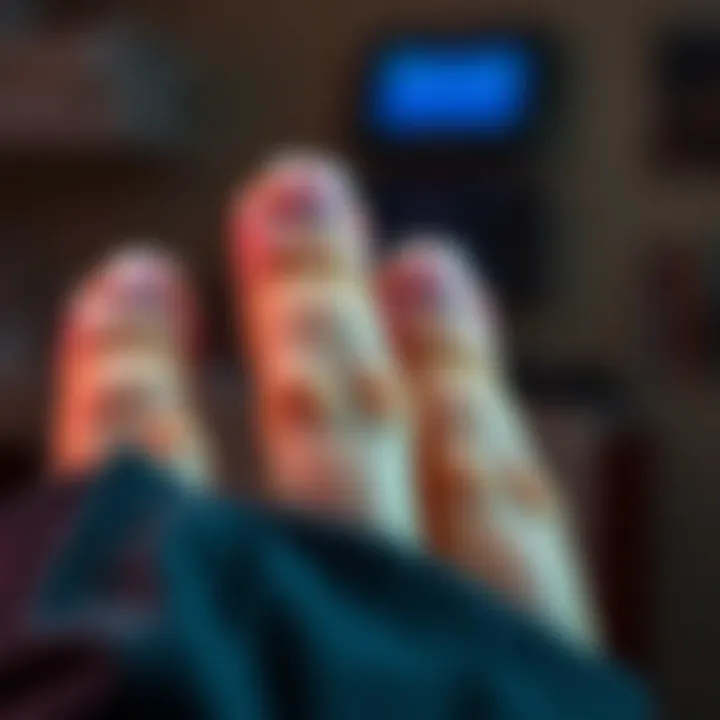
Phototherapy can present an excellent alternative, especially for those who prefer to avoid systemic medications. However, it necessitates regular visits to a specialized clinic and monitoring for potential side effects.
"Understanding how to manage nail psoriasis effectively can make a world of difference in a patient's daily life, reducing not just physical symptoms but also emotional turmoil."
In summary, the treatment approaches for nail psoriasis are multi-faceted, involving a tailored strategy that may include topical medications, systemic treatments, or light therapy options. The choice of treatment often hinges on the severity of the condition and the patient’s response to previous therapies. Consulting a healthcare provider is paramount in establishing an effective treatment plan.
Emerging Research
In the realm of healthcare, particularly when it comes to conditions as nuanced as nail psoriasis, staying on the cutting edge of research is crucial. Emerging research offers a beacon of hope for not just understanding the mechanisms behind the condition, but also for innovating treatment approaches that can improve the quality of life for those affected. As scientists peel back the layers of this complex ailment, they unveil fresh insights that could transform management strategies and patient outcomes.
Importance of Studying Emerging Research
Research into nail psoriasis isn't just about finding new treatments; it's also about comprehending the multifaceted nature of the condition. As more studies are conducted, researchers are discovering that psoriasis isn't merely a skin condition. Instead, it often intertwines with other health issues, presenting a broader challenge that necessitates a holistic approach in treatment. This brings forth a few key benefits to consider:
- Enhanced Understanding of the Condition:
As research evolves, so does the understanding of what triggers and sustains psoriasis under the nails. This knowledge is essential for developing targeted therapies. - Novel Therapeutics:
New drugs and treatment options are constantly being evaluated, offering potential breakthroughs in how nail psoriasis is managed. Tailored therapies can lead to more effective and personalized care for patients. - Connection to Other Comorbidities:
Emerging studies often reveal correlations between nail psoriasis and other health conditions, such as psoriatic arthritis. Recognizing these connections can assist healthcare providers in recommending preventive measures before complications arise. - Patient Education and Empowerment:
As research is disseminated, affected individuals are better informed. This equips patients with the knowledge they need to ask the right questions and advocate for their health in clinical settings.
Novel Therapeutics
The landscape for treating nail psoriasis is always shifting, with researchers tirelessly exploring novel therapeutics. These innovative treatments often take advantage of advancements in technology and a deeper understanding of the immune system's role in psoriasis. Biologics, which target specific pathways in the immune system, have shown promise in reducing symptoms not just on the skin but also beneath the nails. Further exploration into oral medications and targeted topical treatments is ongoing, providing a multi-faceted arsenal against this challenging condition. As with any treatment, the adaptability and response of individuals to these new therapies highlight the need for personalized care plans.
Genetic Studies
Unraveling the genetic factors at play in nail psoriasis could shine a light on not only why some individuals are predisposed to the condition but also how it manifests differently across patients. Genetic studies have unearthed markers associated with psoriasis, offering a glimpse into the hereditary nature of the disease. Understanding these genetic links can pave the way for predictive models that may aid in early diagnosis and tailored interventions. The ongoing dialogue between researchers and clinicians emphasizes that knowledge gathered from genetic studies should influence treatment frameworks, allowing a more informed approach towards managing not just nail psoriasis but psoriasis as a whole.
Lifestyle Modifications
Managing psoriasis, particularly when it comes to those stubborn patches under the fingernails, can significantly benefit from lifestyle modifications. These adaptations not only address symptoms but can also improve the overall quality of life for individuals dealing with this condition. Coping with nail psoriasis is not just about medical treatments; it is about a holistic approach that incorporates dietary changes and stress management techniques into daily routines.
Dietary Considerations
When it comes to managing psoriasis, what you eat can have a direct impact on the severity and frequency of flare-ups. Research suggests that a well-balanced diet that focuses on anti-inflammatory foods may help in minimizing symptoms.
So, what's on the menu? Here are some recommendations:
- Omega-3 Fatty Acids: Foods rich in omega-3s, like salmon, walnuts, and flaxseeds, are known for their anti-inflammatory properties. They help in reducing joint swelling and managing skin conditions associated with psoriasis.
- Fruits and Vegetables: Leafy greens, berries, and other vibrant fruits support the immune system and provide essential vitamins. A vivid plate often equals a healthy plate.
- Whole Grains: Foods high in fiber, such as brown rice and quinoa, can help maintain digestive health. A healthy gut can potentially influence skin health as well.
- Limit Processed Foods: It's wise to steer clear of too much processed and sugary food. These can trigger inflammation, leading to flare-ups.
While dietary changes can be tough to stick to, keeping a food diary might help. You can track your meals and note how they affect your symptoms over time, allowing you to spot any patterns and make necessary adjustments.
Stress Management
Stress and psoriasis have a documented relationship—stress can act as a trigger for flare-ups. Thus, learning how to manage stress is crucial for anyone dealing with this condition. What are some effective stress management strategies you might consider?
- Mindfulness and Meditation: Engaging in mindfulness practices can help ground your thoughts and reduce anxiety. Even a few minutes of focused breathing each day can make a significant difference.
- Physical Activity: Regular exercise is not only good for the body but also for the mind. Whether it’s brisk walking, yoga, or dancing, find a physical activity that suits you and stick with it.
- Social Connections: Maintaining relationships and talking about your struggles with friends or family fosters a support network. Don’t underestimate the power of shared experiences; sometimes, just knowing you’re not alone helps.
- Professional Help: Sometimes, stress can overwhelm you, and talking to a therapist or counselor can provide tools to cope better. Getting professional advice can pave the way for healthier emotional management.
"Taking one step at a time in managing both diet and stress can create rippling effects in improving quality of life for those with nail psoriasis."
Finale
Understanding nail psoriasis is paramount for both affected individuals and healthcare providers. This condition, while often hidden beneath the surface, has significant implications for overall health and well-being. Recognizing the symptoms early and accurately diagnosing nail psoriasis can lead to more effective management strategies that improve the quality of life for those impacted.
Summary of Key Points
In summary, this article has aimed to shed light on various aspects of nail psoriasis:
- Nail psoriasis is a complex condition intertwined with the immune system and genetic factors.
- Clinical manifestations include discoloration, pitting, and separation of the nail from the nail bed.
- Accurate diagnosis requires a thorough clinical examination and may sometimes involve nail biopsies.
- Treatment options range from topical therapies to systemic treatments, catering to individual needs.
- Lifestyle modifications such as dietary adjustments and stress management can significantly aid in symptom control.
These points highlight the need for a holistic approach when dealing with nail psoriasis, ensuring that patients receive comprehensive care that addresses both physical and psychosocial aspects.
Future Directions in Research
Research into nail psoriasis continues to advance, with several areas promising new insights and options for those affected by the condition. Future inquiries may focus on the following:
- Novel therapeutics: Ongoing studies are exploring the effectiveness of new medications that target the underlying biological mechanisms of psoriasis more directly.
- Genetic studies: Understanding the genetic components of psoriasis could lead to breakthroughs in prevention and treatment, fostering personalized medicine practices.
- Microbiome impacts: Recent studies suggest that the skin microbiome might play a role in psoriasis, paving the way for research into how altering gut and skin bacteria could influence psoriasis severity.
These directions not only hold promise for improving treatment outcomes but also emphasize the importance of integrating multidisciplinary approaches to psoriasis management. For further reading, consider exploring Nail Health on Wikipedia or the insights shared in forums like Reddit's Psoriasis Community.







